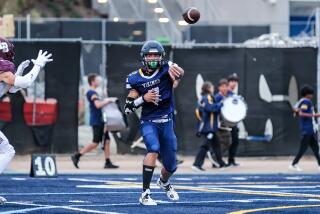UC Riverside Seeks OK for a Medical School
- Share via
With hopes of boosting institutional prestige and answering the pressing need for more doctors in Riverside and San Bernardino counties, UC Riverside officials submitted a formal proposal to University of California officials Monday to create the state’s first research-based medical school in 40 years.
Studies indicate that California is facing a severe shortage of physicians and nurses, with the Inland Empire and its very strong growth projections poised to lag the furthest behind.
The region has the lowest number of primary care physicians per 100,000 residents in the state, according to a 2004 report by the Center for Health Workforce Studies at the State University of New York at Albany.
“It’s time to step up and really make a difference for this very large and growing Inland region,” UC Riverside Chancellor France A. Cordova, who has nudged the university’s medical school plans along for more than two years, said last week.
Roughly 70% of physicians settle in the area in which they serve their residency, UC Riverside officials said.
But officials at Loma Linda University, home to the region’s largest medical school, expressed concern that UC Riverside’s plans could diminish local resources for students. The university admits about 160 medical students a year, with plans to expand, officials said.
Under UC Riverside’s $1.4-billion plan, the medical school would open in fall 2012, enrolling an inaugural class of 40. Operating and capital costs would come both from state funds and private donors. The school would eventually expand to 384 medical students and 157 faculty members, in quarters built in the orange groves of UC Riverside’s undeveloped west campus.
UC officials are expected to decide on the proposal by the end of the year, a UC Riverside spokesman said.
Riverside and San Bernardino counties’ size -- 27,000 square miles stretching to Arizona and Nevada -- makes finding enough family practitioners for nearly 4 million residents a challenge, according to experts.
“That’s our biggest need -- especially in the desert,” said Dr. Janis Neuman, chief of medical services for the Riverside County Department of Public Health.
Neuman has struggled for more than a year to find a family practice doctor for the county’s Indio clinic. She said prospective candidates were deterred by the area’s summer heat and patient population of immigrants, the elderly and the uninsured, many of whom are indigent.
Health officials in both counties complain of bed and nursing shortages, as well as emergency room wait times and ambulances forced to divert to less-crowded hospitals.
Although a new local medical school is not a panacea, “anything that can help us find more primary care physicians is a good thing,” Neuman said.
The university’s proposal does not include building a medical center, but would disperse students among far-flung area medical facilities. UC Riverside already has a two-year biomedical sciences graduate program, which allows medical students to begin at UC Riverside and finish their clinical work at UCLA.
The region “deserve[s] another medical school,” said Dr. Dev Gnanadev, medical director and chairman of the department of surgery at the 373-bed Arrowhead Regional Medical Center in Colton. Gnanadev described children with broken bones forced to travel from Barstow or Needles to Colton for the nearest orthopedic surgeon.
Cordova said she also hoped a new medical school in Riverside would help produce more minority physicians to treat the region’s increasingly diverse population.
UC Merced also has a medical school plan in the works, said Maria Pallavicini, dean of natural sciences at the San Joaquin Valley school. But Pallavicini said Merced’s efforts were not competing with UC Riverside’s. Year-old UC Merced has just 852 students, while long-established UC Riverside has nearly 17,000.
“The need to have a medical school in both places is so compelling that that need cannot be denied,” Pallavicini said.
A recent report by the University of California Health Sciences Committee identified the two regions as likely spots for “severe physician shortages.”
Riverside Mayor Ron Loveridge said he believed a new medical school would improve both residents’ access to healthcare and the local economy, as private research firms are drawn to the new facility.
“It’s good for UCR, it’s good for Riverside and it’s good for the Inland Empire,” Loveridge said.
Officials at Loma Linda University’s medical school, however, are wary.
“If UCR doesn’t plan to build its own academic medical center, it will have an impact on our ability to put our students at Riverside County Regional Medical Center,” said Dr. Roger Hadley, dean of Loma Linda’s school of medicine.
The limited pool of available mentors and teachers at local hospitals will shrink further as Loma Linda works to expand its medical school enrollment from 160 students a year.
If UC officials approve the university’s pitch as expected, the Legislature must then approve the funding.
So far, university officials discussing the plans have had a positive reception in Sacramento, and administrators are optimistic, said Robert Grey, executive assistant to the chancellor for health affairs.
But “the question is always money,” Cordova said.
More to Read
Sign up for Essential California
The most important California stories and recommendations in your inbox every morning.
You may occasionally receive promotional content from the Los Angeles Times.










